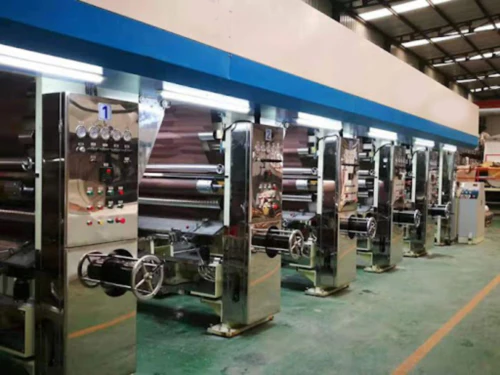Gravure Press Cylinder Engraving Techniques
Introduction
A gravure press, also known as a rotogravure press, is a type of printing press used for high-quality, high-volume printing of images and designs. Gravure printing is a process that involves engraving an image onto a cylinder, which is then used to transfer ink onto the printing substrate.

Advantages and Features
1. Cylinder Engraving
In gravure printing, the image or design is engraved onto a cylinder, typically made of copper or chrome-plated steel. The engraving is done by etching or engraving cells of varying depths onto the cylinder surface.
2. Ink Application
The cylinder is partially submerged in an ink fountain, and excess ink is wiped off the surface using a doctor blade. The remaining ink is held in the engraved cells on the cylinder.
3. Printing Process
As the cylinder rotates, it comes into contact with the printing substrate, typically a flexible material such as paper or plastic. The ink from the cells is transferred to the substrate under pressure, creating the printed image.
4. High Volume Printing
Gravure presses are known for their ability to handle large print runs efficiently. They are commonly used for printing newspapers, magazines, catalogs, packaging materials, and decorative laminates.
5. Image Quality
Gravure printing offers excellent image reproduction with sharp details and vibrant colors. The engraved cells hold a consistent and precise amount of ink, resulting in consistent print quality throughout the print run.
6. Substrate Compatibility
Gravure presses can print on a wide range of substrates, including paper, plastic films, foils, and synthetic materials. The press configuration and ink formulation can be tailored to suit the specific substrate requirements.
7. Drying and Curing
After printing, the ink on the substrate needs to be dried or cured. This can be achieved through various methods, such as hot air drying, infrared drying, or UV curing, depending on the ink formulation and substrate.

Working Principle
1. Engraving
The first step in the gravure printing process is the creation of a printing plate. A cylinder, typically made of copper or chrome-plated steel, is engraved with tiny cells or recesses. The depth and size of these cells determine the amount of ink that will be transferred to the substrate during printing.
2. Ink Application
The ink is then applied to the engraved cylinder, and a doctor blade or a similar device removes the excess ink from the cylinder’s surface. The ink remains only in the engraved cells.
3. Ink Transfer
The substrate, which can be paper, plastic, or other materials, passes between the engraved cylinder and a pressure roller. The pressure roller presses the substrate against the cylinder, and the ink is transferred from the cells to the substrate. The combination of pressure and rotation ensures uniform ink transfer.
4. Drying
After ink transfer, the printed substrate goes through a drying process to evaporate the solvents and fix the ink onto the surface. Various drying methods, such as hot air, infrared, or UV curing, can be employed depending on the ink and substrate.
Applications
1. Flexible Packaging
Gravure printing is extensively used for printing on flexible packaging materials such as plastic films, laminates, and foils. It offers excellent print quality, vibrant colors, and good ink adhesion, making it suitable for food packaging, labels, pouches, and wrappers.
2. Publication Printing
Gravure printing is employed for high-volume publication printing, including magazines, catalogs, and newspapers. It can handle large print runs efficiently and produces sharp images and text.
3. Decorative Printing
Gravure printing is used for decorative purposes, such as printing on wallpaper, gift wrap, and decorative laminates. It enables precise replication of intricate patterns and designs.
4. Security Printing
Gravure printing is utilized for printing security features on banknotes, passports, stamps, and other secure documents. Its ability to reproduce fine details and complex designs makes it suitable for anti-counterfeiting measures.
5. Industrial Printing
Gravure printing finds application in industrial settings, such as printing patterns on fabrics, wallpapers, laminates, and vinyl flooring.

Selection Considerations
When selecting a gravure press, the following factors should be taken into account:
1. Printing Volume
Determine the expected print volume to choose a press that can handle the required production capacity.
2. Substrate Compatibility
Consider the types of substrates to be printed on and ensure that the press can accommodate those materials.
3. Print Quality Requirements
Evaluate the desired print quality, such as image resolution, color accuracy, and sharpness, to select a press that can deliver the required results.
4. Press Size and Configuration
Choose a press size and configuration that is suitable for the available space and production requirements.
5. Automation and Control Systems
Consider the level of automation and control features required for efficient operation and ease of use.
6. Maintenance and Service
Assess the availability of maintenance and service support from the press manufacturer to ensure smooth operation and minimize downtime.
7. Energy Efficiency
Evaluate the energy consumption and efficiency of the press to reduce operational costs and environmental impact.
8. Budget Considerations
Consider the budget constraints and cost-effectiveness of the press, including the initial investment and ongoing operational expenses.
9. Future Expansion and Upgrades
Anticipate future business growth and the potential need for additional features or capacity, and choose a press that allows for easy expansion or upgrades.